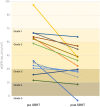Renal Cancer is Not Radioresistant: Slowly but Continuing Shrinkage of the Tumor After Stereotactic Body Radiation Therapy
- PMID: 30803362
- PMCID: PMC6373992
- DOI: 10.1177/1533033818822329
Renal Cancer is Not Radioresistant: Slowly but Continuing Shrinkage of the Tumor After Stereotactic Body Radiation Therapy
Abstract
Purpose: To evaluate the safety and efficacy of stereotactic body radiation therapy for primary lesion of renal cell carcinoma with long-term and regular follow-up of tumor size and renal function.
Methods: This prospective study included 13 patients treated with stereotactic body radiation therapy for primary lesion of stage I renal cell carcinoma between August 2007 and June 2016 in our institution. Diagnosis of renal cell carcinoma was made by 2 radiologists using computed tomography or magnetic resonance imaging. A dosage of 60 Gy in 10 fractions or 70 Gy in 10 fractions was prescribed. The higher dose was selected if dose constraints were satisfied. Tumor response on imaging examination, local progression-free rate, overall survival, and toxicity were assessed.
Results: The mean follow-up period was 48.3 months (range: 11-108 months). The tumors showed very slow but continuous response during long-term follow-up. Three cases (23.1%) showed transient progression during the short follow-up. The mean duration until the day on which partial response was confirmed among the partial or complete response cases was 22.6 months (95% confidence interval, 15.3-30.0 months). Local progression-free rate was 92.3% for 3 years and overall survival rate 91.7% for 2 years and 71.3% for 3 years. Twelve cases (92.3%) had impaired renal function at baseline. Renal function decreased slowly and mildly in most of the cases, but 2 cases of solitary kidney showed grade 4 or 5 renal dysfunction.
Conclusion: All renal tumors decreased in size slowly but continuously for years after stereotactic body radiation therapy. Renal cancer can be treated radically with stereotactic body radiation therapy as a radiosensitive tumor, but careful attention should be given in cases with solitary kidney.
Keywords: kidney cancer; primary lesion; stereotactic body radiation therapy (SBRT); toxicity; tumor response.
Conflict of interest statement
Figures




Similar articles
-
Accelerated Hypofractionated Radiotherapy Versus Stereotactic Body Radiotherapy for the Treatment of Stage I Nonsmall Cell Lung Cancer-A Single Institution Experience With Long-Term Follow-Up.Technol Cancer Res Treat. 2018 Jan 1;17:1533033818806318. doi: 10.1177/1533033818806318. Technol Cancer Res Treat. 2018. PMID: 30317929 Free PMC article.
-
Renal cell carcinoma treated with stereotactic radiotherapy with histological change confirmed on autopsy: a case report.BMC Res Notes. 2014 Apr 26;7:270. doi: 10.1186/1756-0500-7-270. BMC Res Notes. 2014. PMID: 24767701 Free PMC article.
-
Stereotactic ablative body radiation therapy for primary kidney cancer: a 3-dimensional conformal technique associated with low rates of early toxicity.Int J Radiat Oncol Biol Phys. 2014 Dec 1;90(5):1061-8. doi: 10.1016/j.ijrobp.2014.07.043. Epub 2014 Oct 13. Int J Radiat Oncol Biol Phys. 2014. PMID: 25442039 Clinical Trial.
-
When Surgery Is Not an Option in Renal Cell Carcinoma: The Evolving Role of Stereotactic Body Radiation Therapy.Oncology (Williston Park). 2019 May 14;33(5):167-73, 177. Oncology (Williston Park). 2019. PMID: 31095714 Review.
-
Radiation Therapy for Patients with Advanced Renal Cell Carcinoma.Urol Clin North Am. 2020 Aug;47(3):399-411. doi: 10.1016/j.ucl.2020.04.011. Epub 2020 Jun 8. Urol Clin North Am. 2020. PMID: 32600541 Review.
Cited by
-
Combination with Stereotactic Body Radiotherapy Offers a Promising Strategy to Overcome Resistance to Immunotherapy in Advanced Renal Cell Cancer.J Oncol. 2019 Nov 28;2019:1483406. doi: 10.1155/2019/1483406. eCollection 2019. J Oncol. 2019. PMID: 31871454 Free PMC article. Review.
-
Stereotactic body radiation therapy for renal cell carcinoma: a small number of initial clinical experiences.J Radiat Res. 2025 Jul 22;66(4):429-435. doi: 10.1093/jrr/rraf028. J Radiat Res. 2025. PMID: 40460449 Free PMC article.
-
The Landscape of Stereotactic Ablative Radiotherapy (SABR) for Renal Cell Cancer (RCC).Cancers (Basel). 2024 Jul 27;16(15):2678. doi: 10.3390/cancers16152678. Cancers (Basel). 2024. PMID: 39123406 Free PMC article. Review.
-
Stereotactic body radiotherapy for kidney cancer: a 10-year experience from a single institute.J Radiat Res. 2021 May 12;62(3):533-539. doi: 10.1093/jrr/rrab031. J Radiat Res. 2021. PMID: 33866363 Free PMC article.
-
Role of stereotactic body radiation therapy for the management of renal cell carcinoma: tailoring treatment in the era of the "embarrassment of riches".Ann Transl Med. 2019 Jul;7(Suppl 3):S106. doi: 10.21037/atm.2019.05.04. Ann Transl Med. 2019. PMID: 31576313 Free PMC article. No abstract available.
References
-
- Siegel RL, Miller KD, Jemal A. Cancer statistics, 2016. CA Cancer J Clin. 2016;66(1):7–30. - PubMed
-
- Ministry of Health, Labour and Wealth. Vital statistics Japan. 2016. https://ganjoho.jp/reg_stat/statistics/dl/index.html
-
- Hori M, Matsuda T, Shibata A, Katanoda K, Sobue T, Nishimoto H; Japan Cancer Surveillance Research Group. Cancer incidence and incidence rates in Japan in 2009: a study of 32 population-based cancer registries for the Monitoring of Cancer Incidence in Japan (MCIJ) project. Jpn J Clin Oncol. 2015;45(9):884–891. - PubMed
-
- Ljungberg B, Bensalah K, Canfield S, et al. EAU guidelines on renal cell carcinoma: 2014 update. Eur Urol. 2015;67(5):913–924. - PubMed
-
- Campbell SC, Novick AC, Belldegrun A, et al. Guideline for management of the clinical T1 renal mass. J Urol. 2009;182(4):1271–1279. - PubMed

